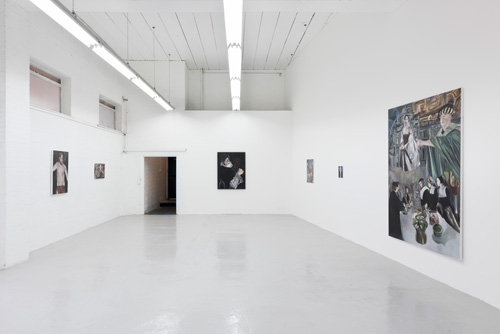

by ALEXANDER GLOVER
Nathan Cash Davidson (b1988) has delighted audiences for the past few years with his unique brand of portraiture inspired by the old masters. Since graduating from Wimbledon College of Art in 2007, he has had his work shown in several group exhibitions in London including at the Hannah Barry Gallery, The Mall Galleries and the Serpentine Gallery. In 2010, at the age of 22, he became the youngest artist to have a solo exhibition at Parasol Unit Foundation for Contemporary Art in London.
There is a distinctly surreal quality to Davidson’s historical paintings. At first glance they don’t necessarily strike the viewer as out of the ordinary. The subject matter, the richness in detail and colour are all fairly traditional. As you spend more time looking, however, it becomes apparent that something is not quite right. Traditional standards, as it were, have been played around with through a warped sense of perspective and a meshing together of various scenes from different times that make up the composition. The surreal nature of his historical paintings is a byproduct of Davidson’s technique and process. His main goal, though, is not to create surreal worlds or project his sense of humour (a phrase that has been wrongly attributed to his work, according to Davidson), but to recreate the past within a modern context.
Alexander Glover: So tell me about the general themes behind the paintings in this show.
Nathan Cash Davidson: I’m really inspired by 16th-century art. I don’t ever copy or refer to any paintings from the period though. Sometimes I’ll use renaissance figures, but they won’t actually be from paintings. They’re usually from films stills or photographs of people dressed up from a play. In the past, I’ve also, for example, taken photographs of Hampton Court and then used those to help formulate a background. The only way to bring back the past is to collage things, as we don’t live in that time. The paintings will always have a modern feeling to them though. This is simply because they’re painted now and not in that era. Even if you’re not trying to make them deliberately modern, they’ll inevitably have a contemporary feel.
AG:Where did the title for the show originate?
NCD: From a prayer in the Bible. I chose it simply because it’s from the past and [because of] the strong historical connotations that quoting from the Bible undoubtedly has.
AG:The perspective in your paintings is often quite off balance and unusual. As a result, some of them have quite a surreal quality. Is this a conscious choice?
NCD: It’s not a conscious choice, no. It’s just how it happens. It’s probably due to how I layer several different scenes together. The unusual perspective is just a natural byproduct of merging them. What is a conscious choice for me is to paint pictures with rich detail. Anything with that richness will satisfy me.
AG:You’ve painted Henry VIII, Mr Punch, George Bush and Ali G. What are your criteria when choosing a subject?
NCD: Well, most of those subjects you’ve mentioned were painted quite a while ago when I was more concerned with contemporary urban stuff. I still aim to experiment with those types of subjects now, but, separately to this, more classically influenced work that I’m exhibiting here at Hannah Barry. In terms of my general criteria when choosing a subject, it can be anybody historical. It doesn’t necessarily have to be a famous historical figure. In fact, I usually choose more obscure characters from films, or I’ll search on Google for people acting in Macbeth, for example.
AG: So you don’t take your influence directly from the past. Instead, you’re more drawn to modern interpretations of the past?
NCD: Yes, because, basically, it’s the only freshness we have of the past. The only way to take inspiration directly from the past is to copy the old masters and that’s not what I’m trying to do, and it’s not what I’ll ever do. Alternatively, I’d love to hire models to dress up in these historical costumes. This is something I intend to do in the future. I’ve done it in the past when I dressed my father up in a Tudor costume. It worked really well because it had a pureness and freshness to it.
In a sense, there are two sides to my work: the experimental sci-fi stuff that is not present in this show, and the more classical. The experimental sci-fi stuff is an ongoing side project of mine, but is what I want to do more of moving forward.
AG:You often merge different scenes and images in your paintings. Would the next step in your compositions be to take photos of scenes you had physically arranged yourself – in other words, to create a tableau?
NCD: Yes, that’s definitely something I’d love to do. I guess I could start doing that with close friends and family. In fact, there is a painting downstairs, a portrait that resembles Jesus, of a close friend of mine. In the painting, my friend is wearing a kilt. The image of the kilt was taken from somewhere else, however, and it’s a prime example of how I use collage in my process to help create images within my own means. It’s just more practical for me at this time. If I were to do a drawing of the countryside and then add in some figures, this could be seen as collage, as I’m putting together difference reference points. To be honest, this is how a lot of the old masters went about producing their paintings. If they wanted to include a floating figure in their painting, they’d have to draw the person lying down or something and then use that as a reference in order to form their composition. This is collage in a way.
AG: Would you say that you’re a historical painter?
NCD: I’m more a modern painter who references history. I think it might be a bit pretentious if I were to describe myself as a historical painter, simply because I’m from the now. The paintings are going to have a contemporary feel to it just from the fact that they’re painted now. Some people have described some of my paintings as being like on a Salvia trip. Sometimes I envisage these kinds of vivid worlds without actually having taken some [Salvia]. The more I think about it actually, the more I agree with the fact that they have a Salvia-trip quality to them. I quite like that.
AG:You are probably the first historically influenced painter, or painter of any sort for that matter, to have also made a name for yourself as a rapper. Tell me more.
NCD: I also write and perform a lot of poetry. There are two strands to the poetry I do: the futuristic, sci-fi urban stuff and the more traditional kind that is heavily influenced by Shakespeare. The themes and imagery I’m concerned with in my poetry are a reflection of what I try to do with my painting. It’s just in a different format. Obviously when I do the rapping, it’s different to my poetry because it has a rhythm that goes to music.
AG: Narrative seems to play a big part for you in your painting, poetry and rapping. Perhaps it would be fairer to describe you as a storyteller?
NCD: That’s interesting. I don’t know how I’d describe myself, to be honest. I just do what I do.
AG: There seems to be a sense of humour to your earlier work. Is that fair to say?
NCD: Yes, I can see why, for sure. The only one that was meant to be funny, intentionally, is this one I did of Alan Sugar. All the others are definitely serious. I think people made a big mistake when the Saatchi description of my work came out and said that I was being sarcastic with the traditional ones I paint. It’s a load of rubbish! I have no intention whatsoever of being sarcastic in my work. My intention is to recreate the past but in the now.
AG: You had your first solo show here at Hannah Barry Gallery seven years ago. Where do you see yourself in seven years’ time?
NCD: I see myself continuing my interest in painting both the traditional and experimental sci-fi urban style of paintings, but with more of a leaning towards the latter. I also hope to create more music and strengthen the link between my music and my paintings. I’m two different artists in the same person.
Nathan Cash Davidson: Thou annointest my head with oil is showing at Hannah Barry Gallery, London, 18 June – 27 July 2015.
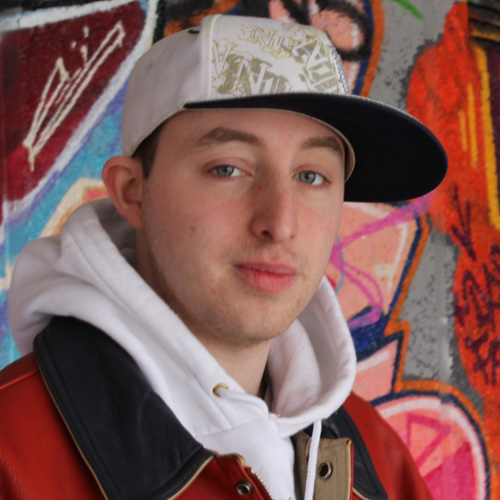
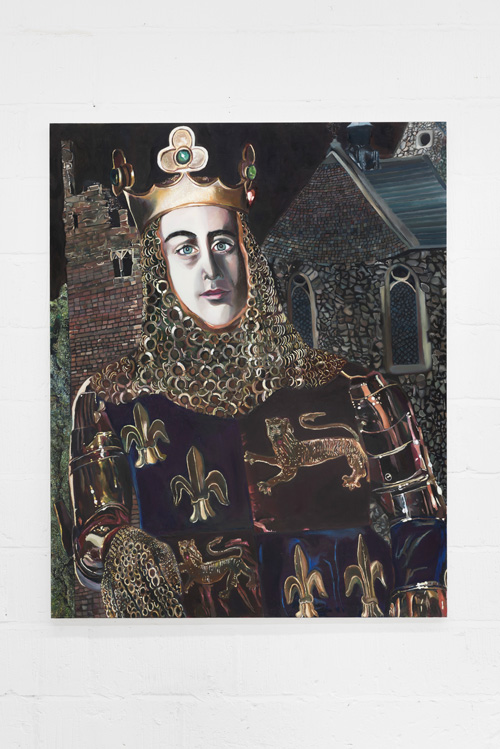
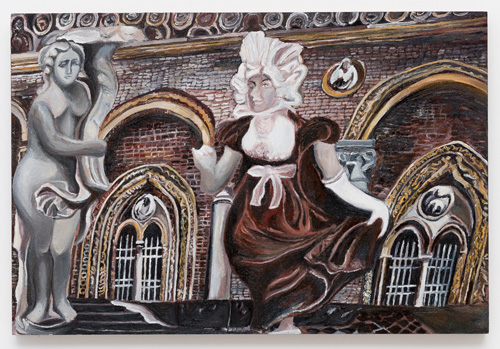
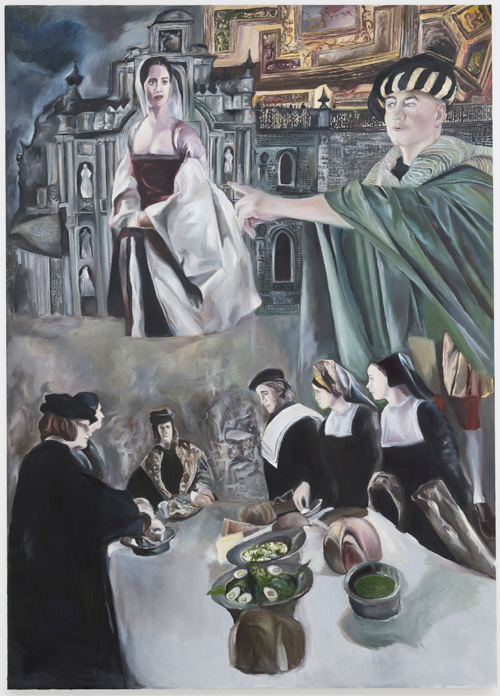
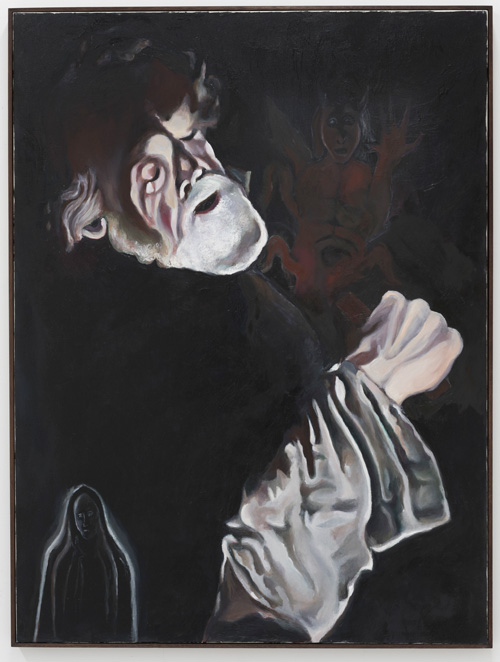
.jpg)
